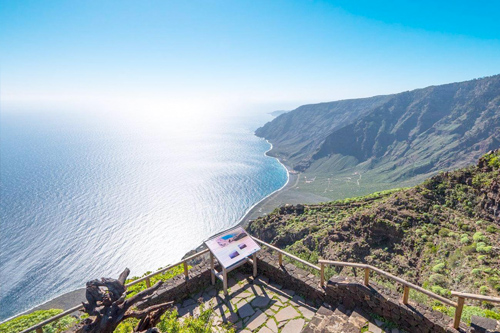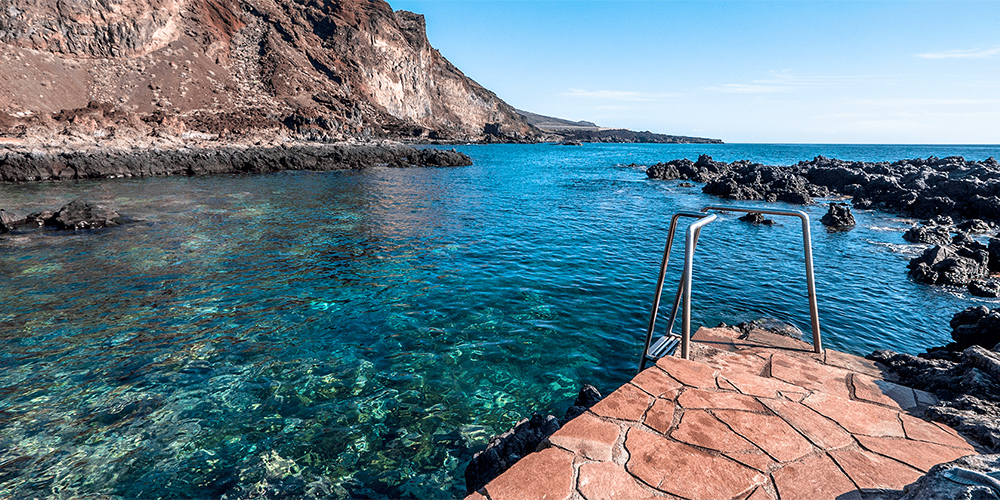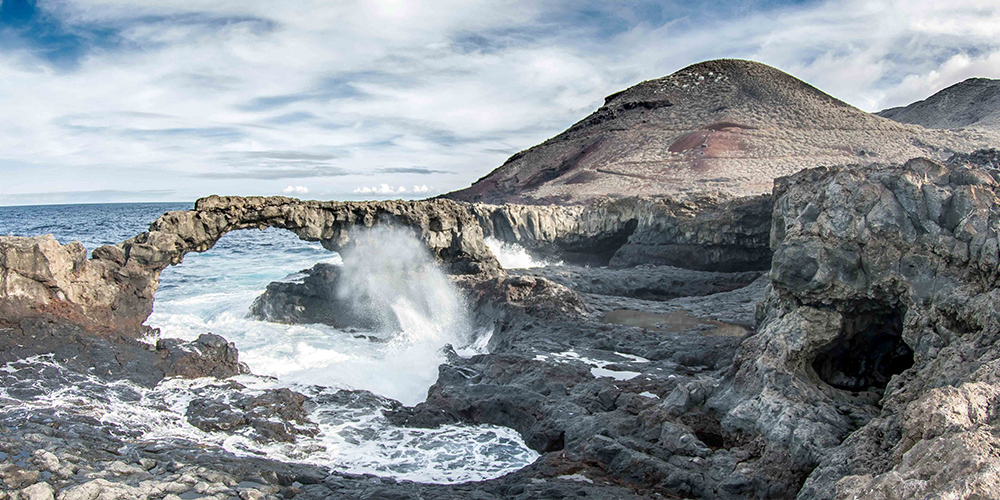EL HIERRO
EL HIERRO is the smallest of the Canary Islands, a UNESCO Biosphere Reserve (2000) and UNESCO Geopark (2014), and a Marine Reserve (1996) with highly controlled small-scale fishing. The island is home to a wide variety of landscapes: cultivated areas (vineyards, pineapples, bananas, etc.), cliffs, lava flows and geological cones, areas of lush vegetation contributing to a high level of biodiversity: laurel forests that are authentic remnants of Tertiary vegetation, oaks, beeches, Canary pines, junipers and many other species.
El Hierro was also the first autonomous island. The island of El Hierro combines the use of wind and water power in the Gorona del Viento hydroelectric power station, inaugurated in 2014, which supplies almost all of the island's 10,000 inhabitants.
With one of the best underwater views in the world, the island offers unforgettable encounters with wild animals that are not afraid of small groups of divers, limited by law. It is also one of the rare places on earth where nature is preserved from mass tourism and where you can forget the notion of time.
THE MIRADORS
Mirador Las Playas
In the shape of an amphitheatre, the Las Playas viewpoint is a balcony overlooking the sea, with its jagged, unspoilt bay and beaches bathed by the dynamic Atlantic Ocean. From the viewpoint, you can see the Parador hotel in El Hierro and the majestic rock of La Bonanza in the distance, and sometimes even Tenerife and La Gomera.
SWIMMING POOLS
Tacorón
A favourite spot for after-dives, Tacorón is built on a lava headland overlooking the Marine Reserve, where you'll find natural pools. Wooden shelters protect you from the sun and the facilities are perfect for barbecues and picnics. The sunsets here are fabulous, with shearwater nests calling in the distance.
Charcos Azul and Charco Los Sargos
Situated in El Golfo, an impressive valley with a steep coastline, this unspoilt enclave represents the whims of volcanoes like no other. Easily accessible on foot, with a wooden solarium and a basalt arch at its crown, these charcos also boast perfect nooks and crannies for the more intrepid wishing to take to the water.
La Maceta pools
These pools are set at different depths and are very easy to get to, so they are suitable for young and old alike, and are most popular in summer. As everywhere else on the island, there are shaded areas with barbecue facilities. The pools are the culmination of a 4 km walk along a wooden path along the coast from the Punta Grande hotel, with magnificent views.
Charcos Manso
The descent is via a spectacular volcanic cone on a red gravel path. The mantle line of the volcanic basalt is extraordinarily beautiful and offers a series of natural arcs formed by the waves beating against the rocks, forming types of geysers. The swimming area is a small cove with a solarium. The water is crystal clear and the sea calm. Charco Manso is one of the island's most enchanting spots.
La Caleta
In the town of Valverde, in the north-east of the island of El Hierro, you'll find the natural pools of La Caleta, an ideal swimming area for taking a dip in the sublime crystal-clear waters. In this enchanting natural setting, visitors can enjoy vast saltwater pools with stairways offering direct access to the sea.
EXURSIONS
La Llanía
On the Route des Crêtes, a magnificent hike accessible to all levels, offering a looped walk through the island's 3 typical landscapes: giant pines, primary forest and volcanic craters. Routes of 3, 5 or 7 km allow you to enjoy the panoramas in complete tranquillity, with a return to the starting car park. The mirador de la Llania offers a magnificent view of the Gulf of La Frontera.
La Orchilla lighthouse and lava tunnel
Dating from 1933, the lighthouse is fully automated and cannot be visited, but its surroundings offer a splendid panorama of the waves breaking over the volcanic reliefs. From the car park at the entrance to the lighthouse, it's a 5-minute walk to the left of the ruins, with a staircase leading down to a lava tunnel. This tunnel is open to the public all year round and is completely safe (headlamps compulsory).
Church of Los Reyes
This small, white, flower-filled 16th-century church is open to the public free of charge every day (except during mass). It houses the famous "Virgin of Los Reyes" (the island's Madonna) in a glass case behind the altar. This doll-sized figurine, adorned with beautiful fabrics and jewellery, emerges from its display case every 4 years for the "Bajada" (procession), during which the whole island is in turmoil: porters and dancers cross the entire island over a period of around a month so that the Virgin can bless the villages as she passes (GR 131).
El Sabinar: the reclining tree
Symbol of the island, this type of Phoenician juniper (Juniperus phoenicea) has grown very slowly and suffers the assaults of the wind, causing it to twist until it touches the ground. Thanks to this ability to adapt to hostile terrain, this tree can live to be more than 1,000 years old. This type of tree can be found all over the windswept area of Sabinosa, and is the starting point for a hike with a viewpoint.
Pozo de las Calcosas
This old fishing hamlet, built on a huge spit of lava, is one of the most unique in El Hierro, giving you the chance to discover the traditional straw roofs that crown most of the houses built from volcanic stone. You can also enjoy the tranquil waters of the natural swimming pool. Although the upper part of the cliff can be reached by car, a pleasant little path with uninterrupted views of the ocean and the winding coastline leads down to the village.
GASTRONOMY
The cuisine of El Hierro reflects a rural society with its characteristic local ingredients, which highlights the purity of the land and its produce, its traditions and the influence of other cultures and eras.
The cuisine of El Hierro has two characteristics: tradition and flavour. El Hierro is a land of Denomination of Origin wines, fresh fish from protected artisanal fisheries, cheeses and typical dishes, thanks to the tradition of livestock farming. The region's distinctive flavours include tropical pineapple and quesadilla, El Hierro's dessert par excellence.
All the coastal villages offer fish, limpets and prawns. Generally speaking, the Herreños are more than happy to share their gastronomy with you and are not stingy when it comes to quantity. As well as local and international restaurants, the "Guachinches", a kind of farmhouse meal, offer typically Herreño cuisine and surroundings. At the end of the meal, many restaurateurs will offer you the "chupito", which allows you to finish the meal before taking your famous siesta.





















